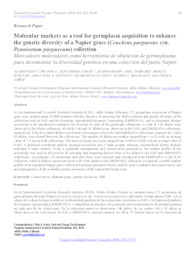Molecular markers as a tool for germplasm acquisition to enhance the genetic diversity of a Napier grass (Cenchrus purpureus syn. Pennisetum purpureum) collection.
Molecular markers as a tool for germplasm acquisition to enhance the genetic diversity of a Napier grass (Cenchrus purpureus syn. Pennisetum purpureum) collection.
Author(s): NEGAWO, A. T.; JORGE, A.; HANSON, J.; TESHOME, A.; MUKTAR, M. S.; AZEVEDO, A. L. S.; LEDO, F. J. da S.; MACHADO, J. C.; JONES, C. S.
Summary: Abstract At the International Livestock Research Institute (ILRI), Addis Ababa, Ethiopia, 171 germplasm accessions of Napier grass were studied using 20 SSR markers with the objective of assessing the allelic richness and genetic diversity of the collections held at ILRI and the Brazilian Agricultural Research Corporation (EMBRAPA), and to determine distinct accessions to be introduced to enhance the diversity in each of the genebank collections. A total of 148 alleles were observed in the whole collection, of which 140 and 93 alleles were observed in the ILRI and EMBRAPA collections, respectively. Fifty-five and 8 alleles were found to be unique to the ILRI and EMBRAPA collections, respectively, while 85 alleles were shared between the collections. The number of alleles per marker ranged from 1 to 23 with an average value of 7.4 across both collections. The heterozygosity per locus ranged from 0.000 to 0.808 with an average value of 0.463. A principal coordinate analysis grouped accessions into 3 main groups, whereas a hierarchical cluster analysis indicated 4 main clusters. From a genebank management and conservation perspective, the marker profile of the accessions was used in the process of selecting and acquiring distinct lines to be added to the ILRI and EMBRAPA collections. Accordingly, 54 accessions and elite lines were selected and introduced from EMBRAPA to the ILRI collection, while 8 distinct accessions from ILRI were added to the EMBRAPA collection. In general, a useful marker profile of an expanded Napier grass collection has been generated which could be used to enhance the conservation, use and management of the available genetic resources of this important forage crop.
Publication year: 2018
Types of publication: Journal article
Unit: Embrapa Dairy Cattle
Keywords: Conservation, Elephant grass, Genetic resources, SSR
Observation
Some of Embrapa's publications are published as ePub files. To read them, use or download one of the following free software options to your computer or mobile device. Android: Google Play Books; IOS: iBooks; Windows and Linux: Calibre.
Access other publications
Access the Agricultural Research Database (BDPA) to consult Embrapa's full library collection and records.
Visit Embrapa Bookstore to purchase books and other publications sold by Embrapa.

